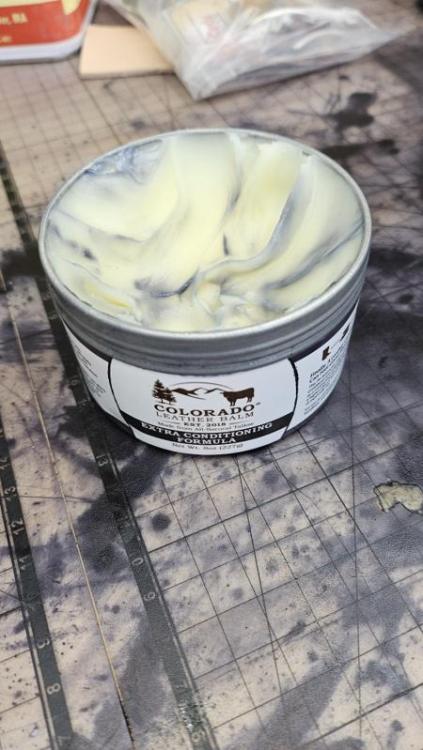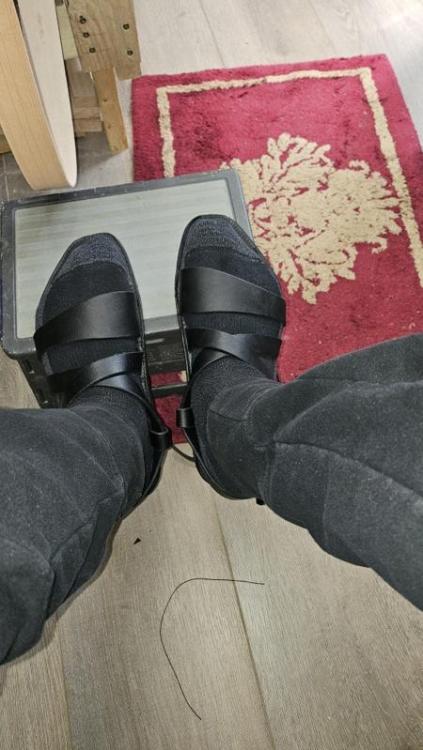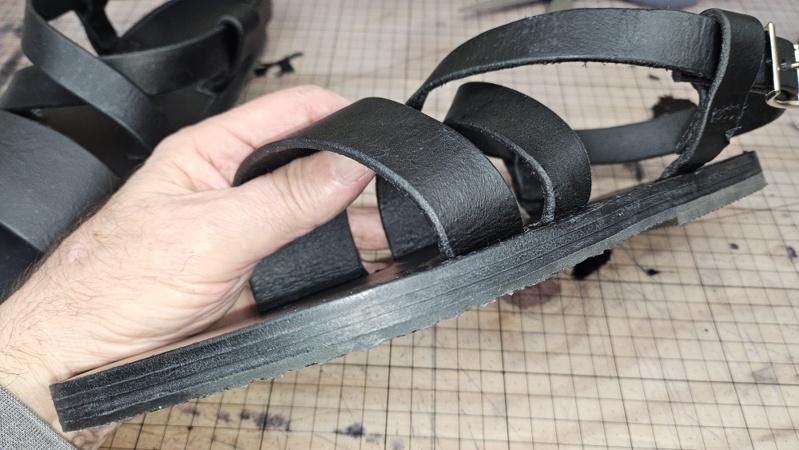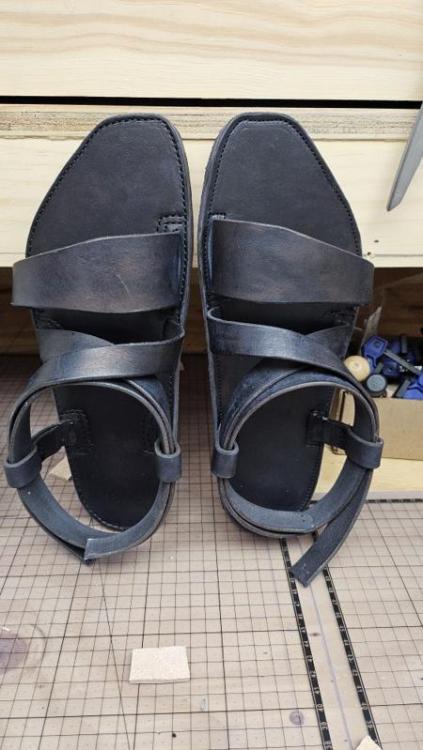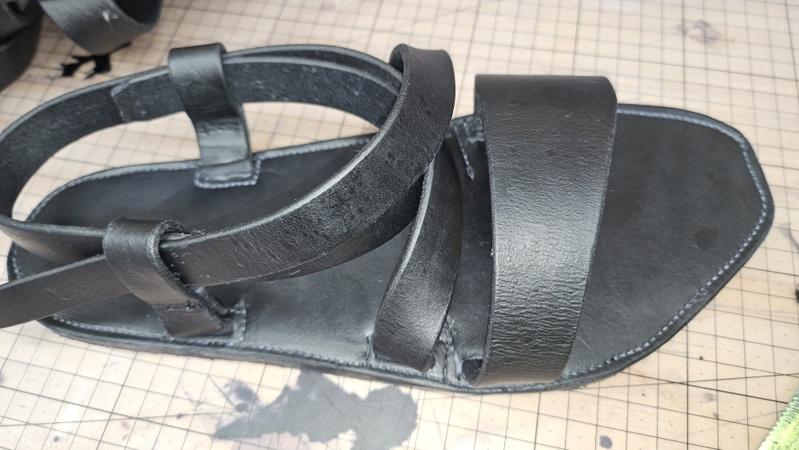
deboardp
Contributing Member-
Posts
189 -
Joined
-
Last visited
Content Type
Profiles
Forums
Events
Blogs
Gallery
Everything posted by deboardp
-
I do have the persistent thought that I spent $12,000 on creating a sandal shop, and I know that using lighter and more supple strap leather, as well as forming the wide part of the front strap to fit the big knuckle better, will possibly make the sandal fit "out of the box". Also I spent 18 months designing that sandal. Did I show a picture of that front strap? It's one complicated piece of leather! I'm interested in seeing if I can make it work. I might make a second pair, with the tweaks to the construction details. If it works, the thing will be a world-class sandal. I'm not saying that out of pride, as in I'm a hot shit, but rather objectively. I always made sandals whose straps were fully adjustable. So this new design is fully adjustable as well. If its is successful, it can be worn with socks. If design #2 is successful (the foot stays centered on the topsole), and is comfortable on day one, and the straps don't stretch at 6.5 ounces, then I can see myself starting an actual shop with an intern who would turn into either an employee or some kind of partner. This would be a high-end leather sandal, and the sales price, retail, would be somewhere around $400 minimum. After all, it will have 5 layers of leather and one layer of gum rubber, plus a harder rubber heel. It could be a little handcraft industry. I am planning to move in the next couple months, so I won't do anything until I"m in my new home, which will be a house, not an apartment. I need the extra room and privacy for my guitar adventure. I was in a couple bands as a young man, and so I need a space that won't cause people to bang on my walls. hahaha. I could use the space for a living room that is now taken up by my 8'c4' leather workbench. Plus I need walk-around-the-bench space, which addes another 6' at least all around, or 14'x10' minimum. That's a big room. Thus, I need a house. so, I'll keep my account open here and show my 6-layer leather and rubber sandal, when it's finished, and actually probably while it's in progress. Maybe I should not show it in progress. Somebody here might become my competitor! Design 2 has a cushion layer under the top sole, That layer will have a leather perimeter, and then a foam insert that will allow the topsole to settle into the foam. Eventually, the foam will become permanently molded to the foot in the sandal, which will help the foot stay centered. It's complicated. The third layer seals the cushion so the straps can slide in the 4th layer's channels. The 5th layer will be the leather bottom sole, to which the rubber bottom sole will be glued. 6-soles! Unheard of. It's preposterous, I know, and maybe stupid. If it works, though, it will be World class. I've got to go for it, make that sandal. It will certainly be labor intensive. Maybe only rich people can buy it.
-
The problem with that pair of sandals is that the strap leather is too thick, and I made it stiff by working fats and oils into it. It will last forever, but my poor feet can't handle how stiff the straps are. I won't wear them. I did put in a bunch of cobbling tacks to change the angle of the straps coming out of the top sole, so that the wide portion over the big toes knuckle doesn't push the knuckle toward the little toe side. that corrected the imbalance, but it made the sandals ugly AF. I bought thinner veg tan leather sides for the straps and soles, but I'll be 79 soon, and I no longer need more income, so I doubt I will make another pair. Instead, I bought a new guitar and associated gear and will resume my interest in playing. I'll keep the shop in my home, just in case I change my mind about wanting to make that pair.
-
small wheel embossing for belt border - how to guide it?
deboardp replied to deboardp's topic in Getting Started
I'm hard-headed and will try these small wheels anyway. Thanks for your input. You're probably right. -
small wheel embossing for belt border - how to guide it?
deboardp replied to deboardp's topic in Getting Started
as @fredk said, Tandy (and others) make small and large embossing wheels for manual application with a handle. Rolling the wheel back and forth in short quick strokes with firm pressure on cased leather gives a good impression. It's laborious, but work is something I enjoy. I looked for that cross you mentioned, and yes, that cross is Orthodox enough for me. Thanks! -
I have an order for 20 belts for monks from the abbott of the local Orthodox Christian monastery, and I want to put a narrow (.2") vine border with a small embossing wheel. I've found several online, the vine border is okay, and a couple others may work, too. But I can't find any info on how to guide the wheel a set distance from the leather's edge. Does anyone know how this is done? Also, I'm trying to find a supplier for Orthodox Christian stamps of the Orthodox Cross, perhaps icons of Christ, the Virgin Mary, a dove, things of that nature. Thanks!
-
How do I make sandals with a top sole that is cushioned
deboardp replied to deboardp's topic in How Do I Do That?
I have weird feet and had to buy custom orthotics to help deal with chronic plantar fasciitis, so I've been thinking about how to incorporate the orthotics into sandals. For me, anyway. I paid $510 for two pair of orthotics, and they have helped me be able to balance myself. I had my feet scanned on a special machine at the chiropractor's office, and I can copy the result into the cushion layer. Where the three arches of the foot are supported in the orthotic, I can cut corresponding leather pieces, and surround it with foam pieces. It will mimic the orthotic. If I actually do this, I'll take pictures. -
How do I make sandals with a top sole that is cushioned
deboardp replied to deboardp's topic in How Do I Do That?
I thought of something. A narrow strip of sole leather, like about 1/4 to 3/8" wide, around the perimeter of the underside of the topsole, glued to it, then a layer of foam for the cushion, that fits between inside the leather perimeter. Then the midsole that will have channels for the adjustable straps to slide through for adjustments. I can find a suitable foam that will give enough for the topsole to conform to the shape of the foot. woohoo. That was easy. I'll use 6-7 ounce leather for all the layers: top sole, perimeter for the foam layer, mid sole for the straps to pass to the other side of the sandal, and the bottom sole. Then rubber sole. 5 layers. Every strap will be easily adjustable by the sandal owner. 100% adjustable. Actually all the straps will be made of one long piece of leather, not cut, but a continuous piece. When I had my shop 1970-1974, I made hundreds of pairs, and all of them had one continuous piece of strap leather, with channels, for the straps. The ankle posts, of course, were separate pieces. -
How do I make sandals with a top sole that is cushioned
deboardp posted a topic in How Do I Do That?
Hi, I no longer have to make sandals, because the government awarded my disability compensation after I was homeless 15 years. Ha! But I have a complete sandal shop set up, and unless someone wants to buy it, I'm stuck with it. I did think I might make myself a pair of sandals, if I could figure out how to make the topsole with something under it that would allow the top sole to settle into the cushion layer, so the topsole and the cushion layer together acted like a memory foam mattress. Anyone who remembers I tried to make a sandal without a strap between the toes might want to know I couldn't keep the foot centered on the sandal, and I gave up on it. Anybody got an idea about the cushion layer? As far as I know, there are no sandal makers on leatherworker dot net. Cheers! Patrick -
Sandal mid and strap opinions
deboardp replied to okiwen's topic in Shoes, Boots, Sandals and Moccassins
You can check out my thread on making a 4-sole custom sandal. It's a monastic sandal, designed for wearing with socks (no flesh showing). I don't recommend this particular monastic design because without a strap between the two big toes, it doesn't keep the foot centered on the sandal. However the 4-sole design is excellent. I used 8 ounce shoulder for the top and I recommend 6.5 ounce veg tan for mid and bottom soles, the three of them glues and stitched. I remove sections of the midsole to create open channels for straps that cross over. I glue (and nail if necessary) gum rubber bottom, 1/8" thick (I forget the iron rating). There are many designs for custom sandals that keep the foot centered on the sandal. I had about a dozen designs when I made sandals in my shop back in the '70's. I had forgotten that without a strap between those toes, the foot wanders on the topsole. (I had a stroke that wiped out my memory functions.) -
I have a LM 26 and have the same problem. I'm not doing leather work any longer, but if I get back to doing some, I will refer to this thread. I know that LM doesn't know how to deal with the clanging noise, and they suggested things that I think made it worse. Of course it's a timing issue. Their head tech had me try things sort of like mechanics do, change a part or a setting, see if that fixes it. It's better to know how to troubleshoot rather than do that. Figure out the problem, and then fix it. These adjustments only make things worse if we're guessing. We need to be smarter than that. Your videos are great quality!
-
UPDATE, SEP 1, 2024 I started my sandal shop almost two years ago, because I was homeless at the time, not having enough income to afford an apartment. I was staying in a spare room at the local monastery, thanks to the gracious abbott. I spent $10,000 using my credit cards and a personal unsecured loan, to buy all the tools and materials I would need to make custom monastic sandals. I did manage to make a pair, and after wearing them, I discovered that my foot would not stay centered on them because the front strap is wider on one side than the other, so the foot gets pushed over. I experimented with changing the angle of the straps exiting the topsole, by using long clinching nails, and I was not happy with the result. It was ugly and uncomfortable. The shoe had to be worn with tight straps, which was painful. I had gotten a HUD-VASH voucher (housing voucher for homeless veterans) and was in an apartment by the time I started making this pair of sandals, but I didn't have enough income to cover all my living expenses. I was using my available credit to cover the shortfall, getting cash advances from my credit cards. I had about 4 months of available credit left, and when that was used up, I would be facing homelessness again, at age 77! Then something amazing happened. The VA approved my claim for disability compensation under The Pact Act, which states, basically, that if a soldier, sailor, airman served in a location where Agent Orange was used, and subsequently developed diseases associated with exposure to the herbicide, then it was presumed that there had been exposure. I had submitted three claims prior to that act being passed and had been rejected each time due to lack of evidence that I had been exposed. So suddenly I found that I had enough to live and pay my living expenses. Being disabled, weakened, by my diseases, having lost much of my cognition and memory functions, and being old, I really don't want to do any kind of work any more. I simply didn't want to have to live in the woods, because in my condition I thought it would be fatal, but now I just want to take care of myself, exercise as much as I can, eat healthy, go to Church services, try to be an actual Christian person. As an aside, if anyone doesn't know how the Pact Act came to be, Jon Stewart, the comedian, went to Congress and yelled at them for putting up obstacles to deprive the men and women who put their lives on the line for their country the care they needed for being disabled by this herbicide. He kept yelling, "Shame on you!" He was really angry. He scolded Congress. They wrote and immediately passed the Pact Act, for which I thank God, because I had prayed to St. Xenia that she intercede with Him to do something about the government. So moving the USG is a miracle, as we all know. Anyway, I'm going to sell the shop. Exercising, eating, washing dishes, going to Church, is about all I can handle. Making sandals, or bags, or belts, is a younger man's work. It needs someone with energy. I know someone who needs an income and a friend is reaching out to him about buying it I did have interest in making regular custom sandals, with strap(s) between the toes. After I made this first pair and realized it couldn't work, I remembered that I had tried making sandals without a strap between the toes, and it didn't work. Not ever. I wish my memory worked! So I was excited to think about that, but I'm just worn out, sick, tired (oh, sick and tired! Where have I heard THAT??) I'll teach this fellow how to make sandals if he wants to buy the shop. I'm really happy to have an income now. I moved to a better apartment, bought a car. and can donate to the Church now. Most of my exercise is simply playing pickleball, which is lots of fun. I'm adding stationary bike work to improve the circulation in my legs, which is compromised due to my heart failure, and I'm trying to work in light free weights for toning and range of motion, but PB seems to take most of my time. Patrick DeBoard PS If I don't find a buyer, I may make something. Perhaps a pair of sandals with a strap between the first two toes. I had about a dozen designs back in the day, when I was making almost 50 pair a week (with an intern). But they were a simple 2-sole soak and form design, not the 4-sole consummate sandal I just made. PPS A monastic sandal has to be worn with socks, thus the no strap between the toes requirement. No flesh can be shown. Strict rules at a monastery. PPPS For those who want to buy an item or two, I won't do it. It's the whole shop or nothing.
-
I was referring to some monks I know who can't find sandals that fit them. I'm not sure if these sandals I'm making, with this design, will help them. I think they will be painful to break in. Without a strap between the two big toes, the straps have to be snug to keep the foot centered. One person had surgery on the bones of his foot to straighten his foot, and my sandals will be too hard for him to break in. The only positive is that the sole and straps will be in the right places, but it seems break in will be painful and arduous. I used to build or insert arches, but now I believe that our feet are well designed for walking and the soles are for protecting them from stones we might step on. We actually have arches in our feet so I don't presume to think I can build arches. Our natural arches are self supporting. If we have flat feet, using shoes with built in arches will hurt our feet. So I make my sandals totally flat. The heel I use is only 1/8" thicker than the 3/4 sole, which is 1/8" thick. I'm considering a softer and thinner leather - a 6.5 ounce luxury vegetable tan side - for the straps. Because my straps are wider, it might be strong enough to resist stretching.
-
I had forgotten about the problem with open toe sandals, but taking my first walk in them brought it back to me. Without a strap between the big toe and the second toe, there's nothing to keep the front of the foot centered on the sandal except that big front strap, which has to be tight during break in, and maybe even after that. All 3 straps, actually, have to be tight. I could only fiddle with them for 30 minutes. They hurt! The straps are only 8 ounces, but the front one varies from 1-7/8" over the big knuckle and 1" even over the small knuckle. I reduce that strap to 13/16" where it comes out of the sole behind the big knuckle. It's a nice fit into the 3/4" nickel Conway buckle. I always used Conway 54 years ago, but they were 1/2". When I saw how my straps stretched out and were only 3/8" after 20 years, I decided next time I'd go 3/4". However I did buy some 1/2", some 5/8", and even some 1", in case a lumberjack needs sandals. It's gonna take some doing for these shoes to break in, and there's going to be some toughening up of tender feet involved. I'm surprised that after stuffing about 3 ounces of an 8 oz can of Colorado Leather Balm and then a bunch of cod liver oil the straps are not softer. I thought of wetting them a little next time but am concerned about stretching. Anybody want to weigh in on how to help the break- in? Feel free!
-
-
Finished them, took them for a walk... pictures first and then a brief introduction to the problem with an open toe design.
-
Thank you, guys. I'm also pleased with how they look so far. The black dye really helps make them look rich. I'm gluing the rubber bottom on. The glue is drying as I type this. I will probably finish them today and will take multiple pictures from all perspectives.
-
It's for quick raising and lowering of the shaft. Otherwise you'd have to turn the handle round and round.
-
Next time I dye a pair I'm going to make a sandal-sized tub for the dye and soak them in it. I had to repeat dying them TWICE. I'm very happy overall with the way they look. I can see leather grain. Here's a Louc after first dye operation. I can see red.
-
My stitching is awful. Haha
-
Hahaha I discovered that I lost my desperate motivation to get sales of sandals, you know, because I now have sufficient income to have a home, and therefore did nothing the last two months. But I finally decided to finish this pair for me. The last five days I have 1) stitched the ankle posts; 2) dyed the leather; 3) hand stuffed the leather with the warm water and hand massage with grease method; 4) let it dry, then rubbed the grease film off. Here's a picture. Tasks that remain are: 1) glue on heel and 3/4 sole; 2) apply and polish with cod liver oil; 3) final fitting/ buckle installation. I don't know why the black thread looks white. Maybe it's the grease. What is the future of my sandal shop? I know some monks who have foot problems and I would like to make them sandals. I might make it known to church members that they can buy a monk a pair if they want.
-
I have several sides of veg tan strap leather, 7/8 oz. The best one, a utility side, has no flaws, came from Tandy. The worst one, a hundred twenty bucks more expensive, has multiple holes through it, a craftsman side. I use it for soles, the Tandy for straps. My memory is awful. The Tandy utility side was on sale, $65 a side. Mine is perfect. The HO side I have is slightly larger and cost $260, with what appears to be spear holes here and there. It does have a firm hand, though. Both sides were selected by the vendor and shipped sight unseen.
-
I used them in the 1970's and again the past two years. Half of everything I buy is from Tandy. They're reliable, and the products are better than okay. One of their stores was bought by the manager and is now Springfield Leather Company. I buy stuff from them, too.
-
I can't backstitch with my Cobra Class 26 - it goes sideways on me. 3 layers of veg tan, but I can spin the work 180 with the needle down and then do 2-3 stitches.
-
Slow. The VA granted my claim for disability compensation after 15 years of homelessness, and now I will not be homeless again. So the frantic need to make and sell sandals is gone. I'm doing more for the Church and less for the sandal shop. But I'm getting closer to completing the first pair. I'll stitch the heel loops next, then glue the heel and gum rubber half sole on, burnish the sandal edges, grease her up, and put the buckle on. Probably burnish before gluing rubber on. I hope they fit!


